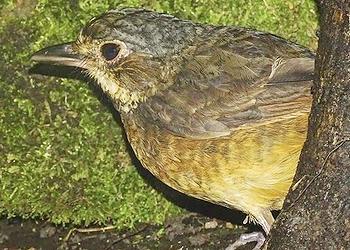
WASHINGTON, DC, July 26, 2017 (ENS) – One of South America’s great bird mysteries has been solved by an international team of researchers working in the forested mountains of western Venezuela.
The scientists have rediscovered the Táchira Antpitta, a plump brown bird not seen since it was first recorded in the 1950s.

The 7.5-inch-long Táchira (say TAH-chee-rah) Antpitta had not been spotted since 1955-56, when ornithologists first recorded and described it.
The International Union for Conservation of Nature (IUCN) lists the species as Critically Endangered, and many feared it was lost for good.
The bird is known only from the locality, at Hacienda la Providencia on the río Chiquito in south-west Táchira, western Venezuela, where four specimens were collected in 1955-1956.
The locality has since been deforested. Although there is still forest nearby; specific searches in September 1990 and December 1996 failed to find the species, according to the IUCN.
But last year, scientists of the Red Siskin Initiative, a conservation partnership between the Smithsonian Institution and several scientific organizations in Venezuela, organized a team to go in search of the antpitta.
The team was led by Jhonathan Miranda of Red Siskin Initiative and Provita, and included colleagues Alejandro Nagy, Peter Bichier of the University of California at Santa Cruz, and Miguel Lentino and Miguel Matta of the Colección Ornitólogica Phelps.
The American Bird Conservancy provided financial support as part of its ongoing Search for Lost Birds.
The team set out in June 2016, knowing that several factors were likely to make the antpitta especially challenging to find, if it even still existed.
The species inhabits dense undergrowth at altitudes of 5,000 to 7,000 feet in a rugged, remote region of the Andes. Difficult to identify visually, the bird differs in coloration in subtle ways from related species.
Antpittas are easier to hear than to see. But without sound recordings, nobody knew what to listen for.
The researchers did have an advantage – they knew where to look.
“We followed the route described in the earlier expedition’s field notebooks to locate the original site of the discovery,” said Miranda.
To reach the site, part of what is now El Tamá National Park, the team traveled by foot on steep, narrow Andean trails, with a mule train to carry their gear. From their camp, the team hiked two hours in the dark to reach the site at dawn, the best time to hear the birds sing.
On the first day, Miranda and Nagy detected the distinctive song of an antpitta they had not heard before. “We were thrilled to re-find the Táchira Antpitta during our first day in the field,” said Miranda, “and we think they persist in more places we have not yet searched.”
Over the next week, the team obtained the first photographs and sound recordings ever made of the living bird.
“The rediscovery provides hope and inspiration that we still have a chance to conserve this species,” said Daniel Lebbin, American Bird Conservancy’s vice president of international programs. “We hope this rediscovery will lead to improved management of and attention for protected areas like El Tamá National Park.”
“El Tamá National Park is an important part of Venezuela’s natural heritage and recognized by the Alliance for Zero Extinction as a critical site to protect for the Táchira Antpitta and other biodiversity,” said Jon Paul Rodriguez of Instituto Venezolano de Investigaciones Científicas, which is the Venezuelan Institute of Scientific Research, Provita, and the IUCN Species Survival Commission.
“Jhonathan Miranda and his RSI colleagues have resolved one of South America’s great bird mysteries, and we hope their findings will contribute to a renewed effort to conserve this species,” said Lebbin.
In the coming months, the team plans to publish the full details of their findings in a scientific journal, including how the Táchira Antpitta’s voice and visual characteristics distinguish it from other similar species.
Copyright Environment News Service (ENS) 2017. All rights reserved.
© 2017, Environment News Service. All rights reserved. Content may be quoted only with proper attribution and a direct link to the original article. Full reproduction is prohibited.
